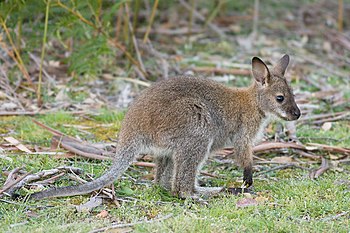 |
| Juvenile Bennett's Wallaby, Tasmania (Photo: Wikipedia) |
Last July, the federal environment minister, Greg Hunt, announced the appointment of Gregory Andrews as Australia’s first Threatened Species Commissioner.
His mission: to help avert the extinction of a growing number of native plant and animal species.
On Andrews’ appointment, a team of scientists was commissioned to go to Bramble Cay, an unstable 4-5 hectare coral bank in the eastern Torres Strait off the tip of northern Australia. The team searched for the Bramble Cay melomys, a small rodent recorded nowhere else but here and not seen since 2007.
The team failed to find any trace of this species, suggesting that another Australian mammal has become extinct. Since European colonisation, 30 mammals (more than 10% of Australia’s mammal species) have shared this fate. Australia has one of the worst extinction records of any country.

More than 1,850 animals and plants are listed as threatened under Commonwealth legislation (the Environment Protection and Biodiversity Conservation Act). For more than 800 of these we know what needs to be done to avert extinction.
The problem is, given the limited funds available, which species to prioritise.
How much money
Australia was recently ranked among the bottom 40 countries for the funding of its share of global biodiversity, considering its governance, size and wealth.
Prioritising which animals and plants to save is controversial because it implies triage - giving up on some to save others. But it has to be done. One way would be to prioritise the species most threatened with extinction. However, the inefficiencies of this method have been well-documented. All states and territories have more complex ways of prioritising species.
We really need a national system; this was a key recommendation of the 2008 Hawke review of Australia’s environmental legislation. Commissioner Andrews is charged with developing such a framework.
The conservation challenge

There’s a tension between iconic species the public would like to see conserved (such as koalas) and critically endangered species that are less well known, but just as important scientifically, such as the mountain mist frog or most native grasses.
For instance, in January 2014 the Australian government committed A$3 million to recover Tasmanian devils, while the Queensland government is investing A$26.5 million between 2012 and 2015 to recover koalas. These investments inevitably draw funds away from other species at risk of extinction.

There are also other species, such as the dugong, seabirds and coastal dolphins, not listed as threatened but listed under international conservation agreements to which Australia is a signatory. Clearly, these species need attention alongside the ones listed as threatened in Australia.
Three red buckets for threatened species

Iconic and non-iconic species require different types of funding. There is also a third category, covered by environmental offsets. In New Zealand, funding for iconic species is explicitly separated from others, which acknowledges the political sensitivity of iconic species.
New South Wales is adopting the same approach. The Australian government could consider doing likewise. Threatened species receive funding from the public and private purse. Another source of funds is offsets. Developments that affect species listed as threatened (or migratory species) must offset the damage by ensuring protection elsewhere.
For instance, current and proposed coal-mining projects in the Galilee basin in Queensland will potentially destroy much of the habitat for the black-throated finch. Almost 170,000 hectares of prime black-throated finch habitat will be required to offset current development approvals.
Offsetting has been used to a limited extent, as in the case of the mallee-fowl in Victoria, and has been suggested for the koala. Using offsets would require a rigorous overhaul of offset policies at all levels of government.
Allocating species to buckets
So how should the different categories of species be funded?
The iconic bilby would ideally be funded from the iconic bucket, containing funds contributed by NGOs, private industry (Pink Lady sponsors Save the Bilby Fund through the sale of its chocolate bilbies), or public-private partnerships.

In contrast, many threatened species, such as nearly 1,300 listed plants, are unfamiliar to the general public and so will probably not attract significant private funding. These species could be funded from the non-iconic bucket, filled largely from the public purse.
Threatened species that are often imperilled by development proposals, potentially requiring offsets, are both iconic (koalas) and non-iconic (growling grass frog). Funding from the offset bucket should be directed mainly to non-iconic species or migratory species - the ones most reliant on limited public funding.
The use of offsetting and private funds should not reduce the government’s duty to threatened species. Rather, the level of resources in the non-iconic buckets should reflect the Australian government’s international commitments to threatened species protection.
For instance, Australia is signatory to several international treaties that protect species. These include the UN Convention on Biological Diversity, the Convention on International Trade in Endangered Species of Wild Fauna and Flora, and the Convention on the Conservation of Migratory Species and Wild Animals.
Such an overhaul of conservation funding could greatly enhance the prospects for Australia’s threatened species and contribute to halting our disastrous record of species extinctions. The commissioner has many opportunities to make a difference.
This article was originally published on The Conversation. Read the original article.
No comments:
Post a Comment